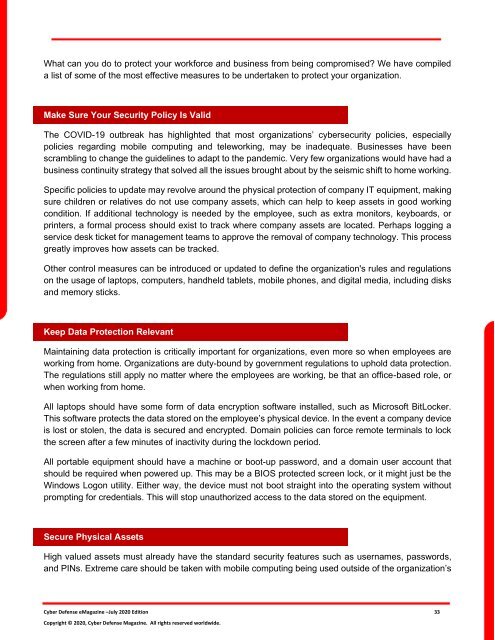Cyber Defense eMagazine July 2020 Edition
Cyber Defense eMagazine July Edition for 2020 #CDM #CYBERDEFENSEMAG @CyberDefenseMag by @Miliefsky a world-renowned cyber security expert and the Publisher of Cyber Defense Magazine as part of the Cyber Defense Media Group as well as Yan Ross, US Editor-in-Chief, Pieruligi Paganini, Co-founder & International Editor-in-Chief, Stevin Miliefsky, President and many more writers, partners and supporters who make this an awesome publication! Thank you all and to our readers! OSINT ROCKS! #CDM #CDMG #OSINT #CYBERSECURITY #INFOSEC #BEST #PRACTICES #TIPS #TECHNIQUES
Cyber Defense eMagazine July Edition for 2020 #CDM #CYBERDEFENSEMAG @CyberDefenseMag by @Miliefsky a world-renowned cyber security expert and the Publisher of Cyber Defense Magazine as part of the Cyber Defense Media Group as well as Yan Ross, US Editor-in-Chief, Pieruligi Paganini, Co-founder & International Editor-in-Chief, Stevin Miliefsky, President and many more writers, partners and supporters who make this an awesome publication! Thank you all and to our readers! OSINT ROCKS! #CDM #CDMG #OSINT #CYBERSECURITY #INFOSEC #BEST #PRACTICES #TIPS #TECHNIQUES
You also want an ePaper? Increase the reach of your titles
YUMPU automatically turns print PDFs into web optimized ePapers that Google loves.
What can you do to protect your workforce and business from being compromised? We have compiled<br />
a list of some of the most effective measures to be undertaken to protect your organization.<br />
Make Sure Your Security Policy Is Valid<br />
The COVID-19 outbreak has highlighted that most organizations’ cybersecurity policies, especially<br />
policies regarding mobile computing and teleworking, may be inadequate. Businesses have been<br />
scrambling to change the guidelines to adapt to the pandemic. Very few organizations would have had a<br />
business continuity strategy that solved all the issues brought about by the seismic shift to home working.<br />
Specific policies to update may revolve around the physical protection of company IT equipment, making<br />
sure children or relatives do not use company assets, which can help to keep assets in good working<br />
condition. If additional technology is needed by the employee, such as extra monitors, keyboards, or<br />
printers, a formal process should exist to track where company assets are located. Perhaps logging a<br />
service desk ticket for management teams to approve the removal of company technology. This process<br />
greatly improves how assets can be tracked.<br />
Other control measures can be introduced or updated to define the organization's rules and regulations<br />
on the usage of laptops, computers, handheld tablets, mobile phones, and digital media, including disks<br />
and memory sticks.<br />
Keep Data Protection Relevant<br />
Maintaining data protection is critically important for organizations, even more so when employees are<br />
working from home. Organizations are duty-bound by government regulations to uphold data protection.<br />
The regulations still apply no matter where the employees are working, be that an office-based role, or<br />
when working from home.<br />
All laptops should have some form of data encryption software installed, such as Microsoft BitLocker.<br />
This software protects the data stored on the employee’s physical device. In the event a company device<br />
is lost or stolen, the data is secured and encrypted. Domain policies can force remote terminals to lock<br />
the screen after a few minutes of inactivity during the lockdown period.<br />
All portable equipment should have a machine or boot-up password, and a domain user account that<br />
should be required when powered up. This may be a BIOS protected screen lock, or it might just be the<br />
Windows Logon utility. Either way, the device must not boot straight into the operating system without<br />
prompting for credentials. This will stop unauthorized access to the data stored on the equipment.<br />
Secure Physical Assets<br />
High valued assets must already have the standard security features such as usernames, passwords,<br />
and PINs. Extreme care should be taken with mobile computing being used outside of the organization’s<br />
<strong>Cyber</strong> <strong>Defense</strong> <strong>eMagazine</strong> –<strong>July</strong> <strong>2020</strong> <strong>Edition</strong> 33<br />
Copyright © <strong>2020</strong>, <strong>Cyber</strong> <strong>Defense</strong> Magazine. All rights reserved worldwide.


















